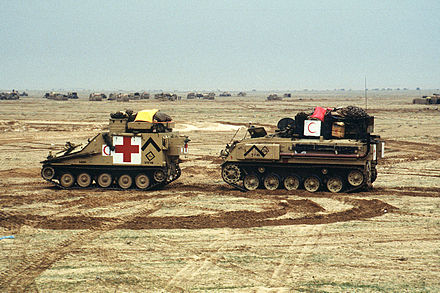Military Alvis
The Hungarian automotive engineer Nicholas Straussler had designed an armoured car (AC1) in 1932, which was built by the Manfred Weiss company under licence in Budapest. When Hungary aligned itself with Germany soon afterwards, Straussler emigrated to England. Straussler's small new company, Straussler Mechanisations Ltd, lacked the necessary resources and capacity to build the vehicle on a large scale, so Straussler approached Alvis, and Alvis-Straussler Ltd, a short-lived joint venture company, was formed in July 1936. The prototype vehicle produced, the Alvis Straussler AC2, was built upon the AC1 chassis. The first AC3 – the first operational purpose-built armoured car ever produced – was delivered in 1937 by Alvis-Straussler Ltd, built upon the AC2 prototype. Twenty-seven vehicles were built: 12 for the Royal Air Force, 3 for the Portuguese Army, and 12 for the Royal Netherlands East Indies Army. The AC2 was subsequently used as a basis for the 39M Csaba armoured scout car built for the Royal Hungarian Army during the Second World War.

An FV104 Samaritan ambulance and an FV432 armoured personnel carrier
In 1938, Alvis produced a prototype armoured light reconnaissance vehicle for comparison trials with other manufacturers. The Alvis Dingo lost out to a design by BSA Cycles but the Dingo name was adopted as a nickname for the BSA design; the Daimler Dingo.
Post-war, Alvis designed a series of six-wheel drive vehicles. The Saladin (FV601) armoured car and Saracen armoured personnel carrier were first. The Saracen was built as a number of related vehicles including FV604 Regimental Command Vehicle, and FV610 Armoured Command Post. The Salamander was an airfield crash tender. It was subsequently used as a basis for the Stalwart amphibious military truck. The FV611 model was also built to serve as an armoured ambulance.
The FV432 tracked armoured personnel carrier and related vehicles was developed in the early 1960s by GKN Sankey and came under Alvis in 1998.
The Combat Vehicle Reconnaissance (Tracked) family of tracked vehicles were designed in the 1960s. The family includes the FV101 Scorpion, FV102 Striker, FV103 Spartan, FV104 Samaritan, FV105 Sultan, FV106 Samson, FV107 Scimitar, FV4333 Stormer, and the Streaker. The first vehicle of this series was the FV101 Scorpion, which was the first aluminium hull tank ever to be built. The hull and turret are actually fabricated from a welded aluminium-zinc-magnesium alloy. Seventeen Scorpion prototypes were delivered for field testing in February 1969.